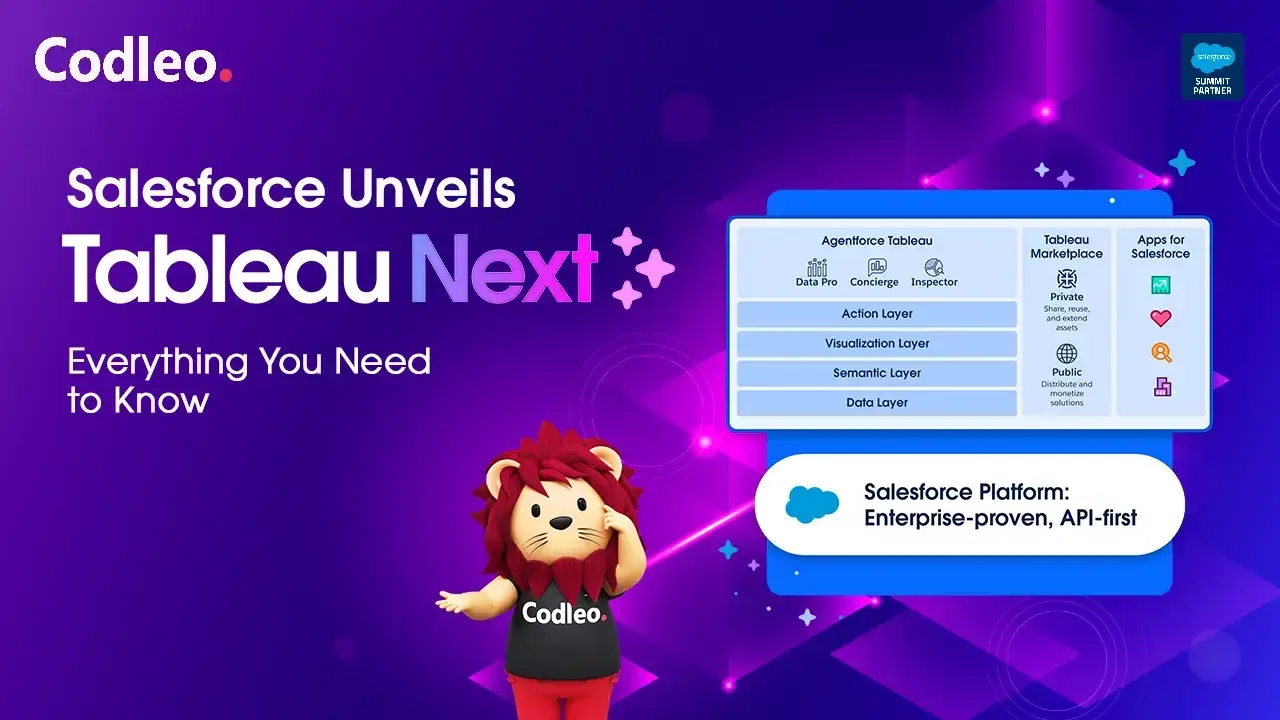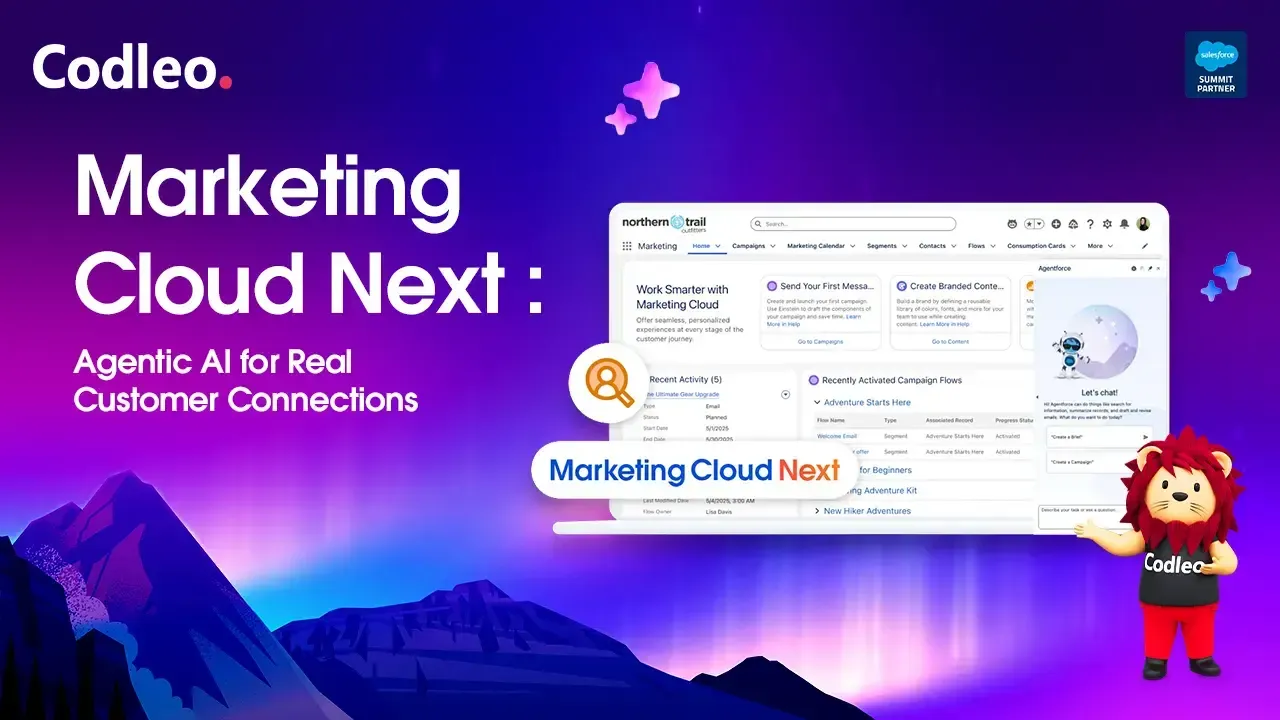Publish date:
Hello, ready to onboard the world’s favourite Customer Relationship Management tool for your business and its future. Well then you have come to the right place to learn more about the Salesforce CRM tool project implementation and Salesforce Implementation Services provided by companies like Codleo. Let’s get down to it, shall we?
Looking to implement Salesforce CRM in your business but don't know where to start? Look no further! In this ultimate Salesforce implementation guide, we will unleash the power of CRM and give you the tools and knowledge you need to take your business to the next level.
Salesforce CRM is a powerful system that can revolutionize the way you manage customer relationships, automate sales processes, and drive business growth. However, implementing it successfully is not a walk in the park.
In this comprehensive guide, we will take you step-by-step through the Salesforce implementation process, from planning and strategy to configuration and customization. We will provide expert tips and best practices to help you avoid common pitfalls and maximize the benefits of Salesforce CRM.
Whether you are a small business owner or an enterprise-level organization, this guide is designed to help you harness the full potential of Salesforce CRM and achieve success in your sales and marketing efforts. Get ready to unlock the power of CRM and take your business to new heights!
Benefits of implementing Salesforce CRM
-
Implementing Salesforce CRM in your business can bring a wide range of benefits that will positively impact your sales and marketing efforts. Firstly, Salesforce provides a centralized platform for managing customer relationships, allowing you to track interactions, gather valuable data, and gain insights into customer behavior. This enables you to tailor your sales and marketing strategies, resulting in improved customer satisfaction and increased revenue.
-
Furthermore, Salesforce CRM automates various sales processes, saving your team time and effort. Features like lead management, opportunity tracking, and forecasting streamline your sales pipeline, ensuring that opportunities are not missed and deals are closed more efficiently. With Salesforce, you can also automate email campaigns, reducing manual work and improving the overall effectiveness of your marketing efforts.
-
In addition, Salesforce CRM offers robust reporting and analytics capabilities, allowing you to measure the success of your sales and marketing activities. You can easily generate reports and dashboards to monitor key performance indicators, track sales targets, and identify areas for improvement. This data-driven approach empowers you to make informed decisions and optimize your sales and marketing strategies.
-
Implementing Salesforce CRM also facilitates collaboration within your organization. With a shared database, your sales, marketing, and customer service teams can access real-time information, ensuring everyone is on the same page. This promotes better communication, enhances teamwork, and ultimately leads to a more cohesive and efficient organization.
-
Overall, implementing Salesforce CRM enables you to streamline your sales and marketing processes, improve customer relationships, and drive business growth. By harnessing the power of CRM, you can stay ahead of the competition and achieve long-term success.
-
Key considerations before implementing Salesforce
-
Before embarking on your Salesforce implementation journey, there are several key considerations to keep in mind. Firstly, it is crucial to define your objectives and goals for implementing Salesforce CRM. What specific challenges are you looking to address? What are your desired outcomes? Identifying your objectives will guide your implementation strategy and ensure that Salesforce is aligned with your business needs.
-
Another important consideration is understanding the readiness of your organization for CRM adoption. This involves assessing the skills and capabilities of your team, as well as evaluating your existing systems and processes. It is essential to have a solid foundation in place before implementing Salesforce to ensure a smooth transition and maximize the benefits of CRM.
-
Furthermore, budgeting and resource allocation are crucial aspects to consider. Implementing Salesforce CRM involves both financial and human resources. It is important to allocate a sufficient budget and ensure that you have the necessary expertise and personnel to support the implementation process. This may involve hiring consultants, training your team, or dedicating internal resources to the project.
-
Lastly, change management is a critical consideration. Implementing Salesforce CRM involves a significant shift in how your organization operates. It is important to communicate the benefits of CRM to your team, address any concerns or resistance to change, and provide adequate training and support throughout the implementation process. A well-planned change management strategy will ensure a smooth transition and increase user adoption of Salesforce.
-
By carefully considering these key factors before implementing Salesforce CRM, you can set yourself up for success and ensure seamless integration into your business processes.
Steps to successfully implement Salesforce
Implementing Salesforce CRM requires careful planning and execution. By following a systematic approach, you can ensure a successful implementation that meets your business needs. Here are the key steps involved in implementing Salesforce:
Setting up user roles and permissions in Salesforce
One of the key aspects of a successful Salesforce implementation is setting up user roles and permissions. By defining user roles and assigning appropriate permissions, you can ensure that your team members have the right level of access and control within Salesforce CRM.
Customizing Salesforce to meet your business needs
Salesforce CRM provides a wide range of customization options that allow you to tailor the system to meet your specific business needs. By customizing Salesforce, you can optimize your workflows, improve user experience, and align the CRM system with your unique processes. Here are some key areas where you can customize Salesforce:
Integrating Salesforce with other systems
Integrating Salesforce with other systems and applications can significantly enhance the functionality and value of your CRM system. By connecting Salesforce with your existing tools and platforms, you can streamline workflows, improve data accuracy, and enable seamless data exchange. Here are some key benefits of integrating Salesforce with other systems:
Training and onboarding your team for Salesforce
Training and onboarding your team for Salesforce is crucial to ensure a successful implementation and maximize user adoption. By providing comprehensive training and support, you can equip your team members with the necessary skills and knowledge to effectively use Salesforce CRM. Here are some best practices for training and onboarding your team:
Best practices for ongoing Salesforce management
Implementing Salesforce CRM is not a one-time task; it requires ongoing management and optimization to keep it running smoothly and to continue reaping the benefits. In this section, we will explore some best practices for managing Salesforce CRM on an ongoing basis.
-
Regularly Review and Update: Set a schedule to regularly review and update your Salesforce CRM configuration. As your business evolves, your processes may change, and new requirements may arise. Ensure that your Salesforce CRM system is aligned with these changes and optimized for maximum efficiency.
-
Data Quality Management: Data quality is key to the success of any CRM system. Regularly monitor and clean up your data to ensure accuracy and completeness. Implement data validation rules, duplicate management tools, and data enrichment processes to maintain high-quality data.
-
Continuously Improve Workflows: Keep an eye on your business processes and workflows to identify areas for improvement. Leverage Salesforce CRM's reporting and analytics capabilities to gain insights into bottlenecks, inefficiencies, or missed opportunities. Use this data to optimize your workflows and drive continuous improvement.
-
Stay Up-to-Date with New Features: Salesforce CRM releases regular updates with new features and enhancements. Stay informed about these updates and evaluate how they can benefit your business. Adopt new features that align with your goals and provide added value to your team and customers.
-
Leverage AppExchange and Salesforce Community: Salesforce AppExchange is a marketplace for pre-built applications and integrations. Explore the AppExchange to discover tools that can extend the functionality of your Salesforce CRM system. Additionally, join the Salesforce Community to connect with other users, share best practices, and seek advice.
-
Regularly Train and Support Users: Ongoing training and support are essential for keeping your team engaged and knowledgeable about Salesforce CRM. Provide refresher training sessions, conduct knowledge-sharing sessions, and offer dedicated support channels for users to seek assistance when needed.
By following these best practices for ongoing Salesforce management, you will ensure that your Salesforce CRM system remains optimized, up-to-date, and continues to deliver va
Salesforce CRM or many of the cloud-based products for different domains & roles are here to automate tasks, improve efficiency and productivity, increase revenue, and bring businesses closer to their clients. But like all tech onboarding it needs to be handled with care to ensure success at the end of the day. In this blog, we look at ways to ensure a successful Salesforce implementation.
-
Be open to different implementation strategies. If your departments are doing well but they need extra help, then you can get the Salesforce Implementation Services company to just automate / digitize processes and workflows. This way your business challenges are addressed. Businesses should be open to Salesforce implementation & customisation of current processes or overhaul the processes department wise and design fresh processes for each team as per their needs.
-
Planning the implementation journey. As with everything in life, planning Salesforce Implementation Services calls for detailed planning and brainstorming. A well thought out plan needs crafting. Al stakeholders need to be involved. Step by step with timelines, task allocation and budget. All this in consultation with a great Salesforce Implementation Services provider like yours truly. The steps to be followed in a Salesforce implementation plan can vary based on the project’s scope and approach to implementation. The steps usually begin with consultation & information gathering and end with user training as well as support services.
-
Be mindful of deadlines, schedules, and budget. We all need to be realistic and practical. A salesforce project timelines and budget vary as per the complexities, moving parts and customisation needed. It’s always good to plan in detail and not be in tough deadlines that induce pressure and result in human errors. Salesforce Implementation Services. Budgets also need to be defined but realistic. Projects can go askew and timelines for a toss. So, a project manager as part of Salesforce Implementation Services must be strict and mindful.
-
Having the right professional Salesforce Implementation Services partner. Salesforce has 1.5 lakh registered partners worldwide. Partnering with one is the best for companies, big or small. Leaving it to the professional ensures a smooth rollout using best practices, experienced team, and right tech tools. Summit tier partners like Codleo are just what you need to get it right, the first time. They come with a large team of certified and experienced personnel, so you remain a priority and project is not delayed. Look for a boutique partner like Codleo where every project & client is special and a VVIP.
For successful Salesforce Implementation services or lightning migration or support services or integration with your company’s existing tech stack, call Codleo the leader in Salesforce Implementation Services.
Conclusion: Unlocking the full potential of Salesforce CRM
Congratulations! You have reached the end of the ultimate Salesforce implementation guide. By following the steps outlined in this guide, you are well-equipped to unleash the power of CRM and take your business to new heights with Salesforce.
Remember, successful Salesforce implementation requires careful planning, strategic customization, comprehensive training, and ongoing management. Stay proactive, continuously evaluate and fine-tune your system, and leverage the vast resources and community support available in the Salesforce ecosystem.
Now it's time to take action. Start implementing Salesforce CRM with confidence, and unlock its full potential to transform your customer relationships, streamline your sales processes, and drive business growth. Embrace the power of CRM and watch your business thrive!
Also Read: TOP CHALLENGES TO SALESFORCE IMPLEMENTATION















